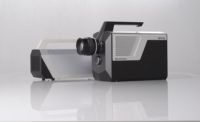Engineers and researchers typically reach for sensors when they want to evaluate the stress-strain characteristics of materials or look at how applied forces affect objects, but now there’s a better way.
Rather than directly instrumenting the object under study, you can use high-speed cameras and specialized software to optically measure deformation, displacement, and strain. The technique is called Digital Image Correlation (DIC), and it’s rapidly growing in popularity in the aerospace, defense, and automotive industries.
When performing a DIC analysis, first apply a speckle pattern to the surface of the object you want to study. The cameras and DIC software then record and analyze the pattern’s movement in response to an applied force, revealing areas of strain and displacement. DIC can be performed with single or multiple cameras that have been synchronized to record at various angles. A one-camera setup will produce a 2D image to analyze elongation, tensile strength or single-plane distortion. Multiple camera systems, which are more common, produce 3D images that offer insight into multi-plane vibration or distortion analysis.
Whichever type of DIC setup you choose, the technique has compelling advantages over traditional sensing methods. DIC is noncontact, a key feature because sensors’ mass can alter an object’s displacement or deformation, and provides more data than the discrete data points collected by sensors. DIC is also fast, inexpensive, and easily integrated.
Here’s a look at three projects that have applied DIC to vibration analysis, impact testing, and large-scale structural analysis.
Diagnosing Vibration in Rotating Machines
Measuring the vibration data of rotating structures is challenging because traditional sensors must pass signals through electrically noisy slip rings. There is also a limit to how many sensors can be attached to rotating structures without changing how the structure moves. University of Texas at Austin researchers showed that DIC makes it possible to collect vibration data from a rotating blade and conduct modal analysis (Rizo-Patron, 2015).
To capture images, the investigators used two high-speed digital cameras, which can record 3,200 images per second at full 1280 x 800 resolution. They tested their approach on a two-meter helicopter rotor excited by a jet of compressed air, capturing images at 1,000 Hz with the blade rotating at 900 RPM. Results suggest that combining DIC with high-speed cameras is effective for determining the modal parameters of rotating systems.
Measuring Blunt Impact Forces on Football Helmets
Researchers at the University of Southern Mississippi used 3D DIC to evaluate the performance of commercially available football helmets under blunt impacts. A helmet was placed on a linear impact table, where it was strapped to a simulation dummy head and then struck by a pressurized punching device at high velocities. The researchers used cameras which captured impact at 3,333 fps, and cameras to capture impact at higher frame rates. Using DIC algorithms, the software produced corresponding videos of the principle strain, displacement, and tangential strain caused by the impact, providing quantitative data that will influence the development of safer helmets.
Scaling Analysis to Large Structures
Conducting large-scale analysis with traditional sensors can be onerous, so University of Grenoble in France researchers used DIC for full-field analysis to study how timber-framed structures respond to seismic activity (Sieffert, 2016). The analysis involved capturing the displacement of a full-scale house undergoing simulated earthquakes on a shake table. The researchers had to balance image resolution to clearly see damage, while gathering full-scale measurements. They used software and a camera at a maximum resolution of 2560 x 1600. For each simulated earthquake, they acquired 7,599 images, tracking almost 4,000 pixels.
Researchers also added contact measurement devices to the structure to measure shake table displacement, which DIC analysis provided in the x and y directions. DIC also exposed an opening in infill material and provided information on the timber’s flexural behavior. The researchers concluded that DIC field displacement measurements provided direct proof of the seismic-resistant behavior of a filled timber-framed structure.
These three applications are just a glimpse of what DIC can do. With the right cameras and software, DIC’s ability to provide full-field, quantitative information about stress, strain, and vibration continues to open up new applications every day.
Speed Matters—Choosing a Camera for Digital Image Correlation
The cameras used for DIC can make a difference in the quality of data obtained and the types of analysis possible, and the type of analysis DIC supports can also determine the best camera for the job. The speckles used for DIC create fine, high-contrast visual textures that are best imaged with high-resolution cameras that can maintain a high frame rate and good image quality. For many DIC applications, cameras with resolutions of 2 to 4 megapixels with frame rates of hundreds of fps work well.
Measuring the stress or strain that results from a very fast phenomenon, such as an impact or a fast loading situation, requires cameras that can image fast enough to capture the quickly changing speckle pattern. Studying impact or fast loading situations can require a trade-off in camera resolution to achieve the high frame rates needed. Cameras that acquire tens of thousands of frames per second with one megapixel or less resolution work well.
Some applications, such as vibration testing, require extremely fast cameras. DIC can measure vibrations and a material’s response to vibrations in various locations over the entire analyzed field. This means analysis of high vibration frequencies (where the response to vibration can be in the tens of thousands of hertz) requires a camera that can image at hundreds of thousands of frames per second.
Lighting can also influence DIC camera choice. If the material being analyzed is plastic or rubber, it might melt or change characteristics at increased temperatures. This means a strong light could cause the sample to respond differently during analysis. A sensitive camera can lessen the amount of lighting necessary to obtain good images.









